In today’s world, rapid urbanization, population growth, and industrial expansion have significantly increased the need for efficient sewage disposal and waste water treatment solutions. Proper sewage purification is essential for maintaining environmental sustainability and ensuring public health. Modern sewage treatment plants (STPs) are at the forefront of this challenge, offering innovative technologies designed to meet the evolving demands of sewage management and water disposal. Among these modern solutions, our packaged sewage treatment plant SUSBIO ECOTREAT stands out as a leading product, delivering exceptional results in various sectors. In this blog, we will explore the role of modern STPs, the revolutionary SUSBIO ECOTREAT, and why it’s the best choice for addressing sewage water and excreta disposal challenges in today’s world.
What Are Sewage Treatment Plants?
A sewage treatment plant, also known as a wastewater treatment plant (WWTP), is a facility designed to treat sewage through a comprehensive waste treatment process. Sewage is a complex mixture of water-carried wastes, and its composition varies depending on its source. The primary goal of an STP is to remove contaminants and convert wastewater into a form that can either be safely returned to the environment or reused as reclaimed water. The treatment of sewage is crucial for environmental protection, water pollution control, and public health.
Understanding the sewage treatment process is more important than ever due to global concerns about water quality and scarcity. The composition of sewage and sewage characteristics can include high levels of organic matter, nutrients, and potentially harmful microorganisms. Traditional STPs focus on separating solids from liquids and neutralizing harmful bacteria, but modern sewage treatment processes have gone a step further by incorporating cutting-edge technology that enhances efficiency, reduces environmental impact, and minimizes operational costs.
Key Features of Modern Sewage Treatment Plants
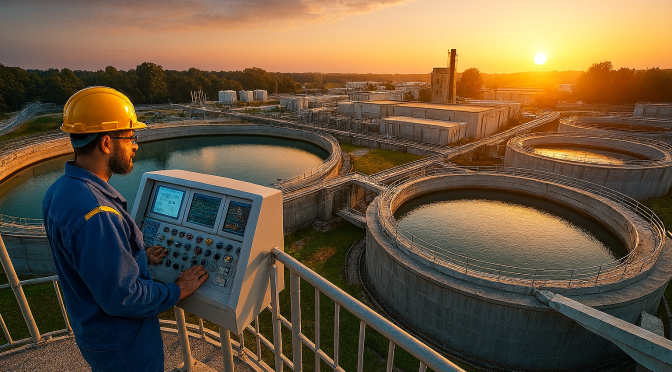
Modern STPs utilize advanced technologies and processes to deliver higher-quality treatment. Some key features include:
Advanced Biological Treatment: Unlike older systems, modern plants incorporate biological processes such as Sequential Batch Reactors (SBR), Membrane Bioreactors (MBR), and Moving Bed Biofilm Reactors (MBBR). These methods are efficient in removing organic matter, nitrogen, and phosphorus, making the treated water much safer for reuse. The activated sludge process is a prime example of such advanced biological treatment, often taking place in an aeration tank.
Automation and Smart Control: Automation systems and real-time monitoring help optimize the operation of STPs, reducing human error and ensuring that the plant runs at maximum efficiency. These intelligent control systems can adjust treatment processes based on real-time water quality data, making the system highly adaptable.
Energy Efficiency: Modern sewage treatment plants are designed with energy efficiency in mind. Innovations like anaerobic digestion (which produces biogas) and the use of solar power have minimized energy consumption. This not only reduces operational costs but also helps decrease the plant’s carbon footprint.
Modular and Packaged Designs: Modular and prefabricated sewage treatment plants, like SUSBIO ECOTREAT, offer flexibility in design and installation. These units are quick to deploy and require minimal space, making them ideal for urban areas or remote locations where on-site treatment is necessary.
Enhanced Sludge Treatment: Sludge, a byproduct of wastewater treatment, can now be processed more effectively through modern systems. Methods like dewatering, composting, and energy recovery from sludge reduce waste and provide additional resources such as energy and fertilizers. Sludge digestion and waste stabilization processes play a crucial role in this aspect of sewage treatment.
Environmental and Economic Benefits of Modern Sewage Treatment Plants
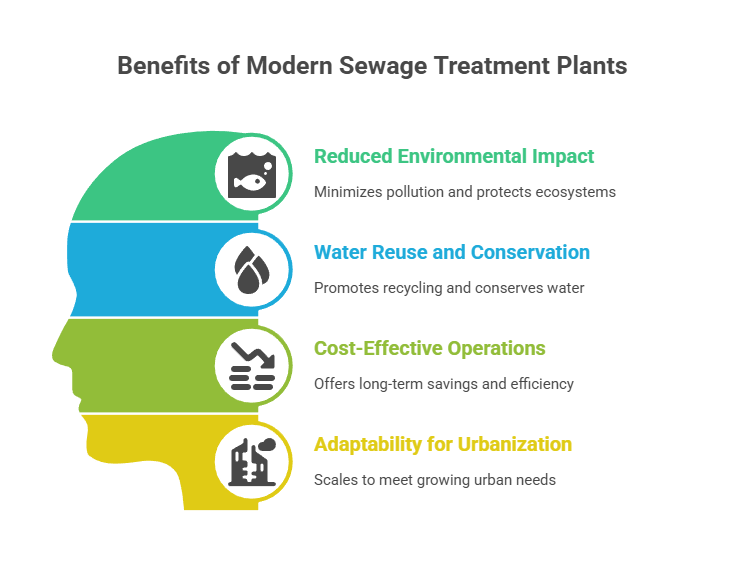
Investing in modern STPs is not only about meeting regulatory requirements; it also offers several environmental and economic advantages:
Reduced Environmental Impact: Modern treatment plants effectively reduce the release of harmful pollutants into water bodies. By improving the removal of contaminants such as heavy metals, organic matter, and excess nutrients, they help prevent water pollution and protect aquatic ecosystems.
Water Reuse and Conservation: With advanced filtration systems and disinfection processes like UV disinfection, modern STPs produce high-quality treated water that can be reused for non-potable purposes like irrigation, industrial use, and landscaping. This promotes water recycling, especially in regions facing water scarcity.
Cost-Effective Operations: While the initial investment in modern STPs may be higher, the long-term savings in operational and maintenance costs make them highly cost-effective. Automation, energy efficiency, and improved sludge management reduce manpower and energy expenses, offering an attractive return on investment.
Adaptability for Urbanization: As cities expand, modern modular STPs can be easily scaled up or adapted to accommodate increased wastewater flows. Their compact designs and flexibility make them a perfect fit for rapidly growing urban centers.
SUSBIO and SUSBIO ECOTREAT: Revolutionizing Modern Sewage Treatment
SUSBIO, a leading sewage treatment plant manufacturer in India, has designed the SUSBIO ECOTREAT system to tackle the challenges of modern wastewater treatment. The SUSBIO ECOTREAT is an advanced, prefabricated sewage treatment plant that uses a dual biological and physical process to ensure superior wastewater treatment.
Here’s how the SUSBIO ECOTREAT system works:
Primary Treatment: In this initial phase, the sewage undergoes grit removal and screening to remove large solids and debris. This helps reduce the load on subsequent treatment processes and takes place in a settling tank. Flow equalization is also implemented at this stage to ensure consistent treatment efficiency.
Secondary Treatment: The heart of SUSBIO ECOTREAT lies in its secondary treatment phase, where it uses a biological process to break down organic pollutants. This phase involves a Moving Bed Biofilm Reactor (MBBR), where microorganisms grow on small plastic carriers that move freely within the tank. These microorganisms degrade organic material efficiently, reducing the biochemical oxygen demand (BOD) and chemical oxygen demand (COD) levels in the water. This process is similar to the activated sludge process but with enhanced efficiency. Secondary sedimentation follows to separate treated water from biological solids.
Tertiary Treatment: After the biological treatment, the water undergoes a physical filtration process to remove any remaining suspended solids, followed by disinfection using ultraviolet (UV) light. This advanced treatment ensures the treated water is free of harmful pathogens and safe for reuse or surface water discharge.
Sludge Management: One of the key benefits of SUSBIO ECOTREAT is its efficient sludge treatment system. The sludge generated during the treatment process is minimized through advanced dewatering techniques, making disposal easier and more environmentally friendly.
Final Treated Water: The final treated water meets stringent water quality standards and can be reused for non-potable applications like landscaping, irrigation, or industrial processes, helping conserve valuable water resources.
Why Choose SUSBIO ECOTREAT?
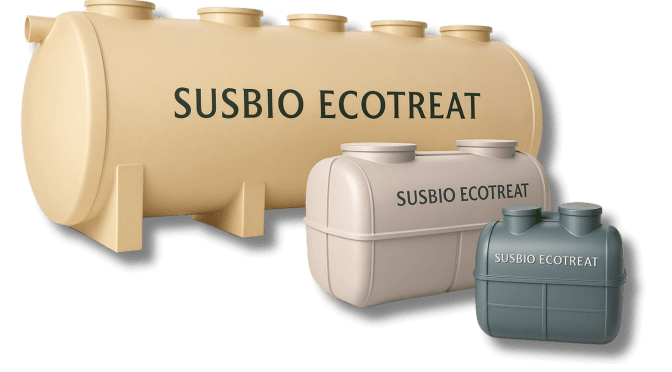
SUSBIO ECOTREAT offers several advantages over traditional sewage treatment systems, making it the best choice for modern wastewater management:
Prefabricated and Modular Design: SUSBIO ECOTREAT is a prefabricated, modular system, making it easy to install and operate in a wide range of environments, from residential complexes to industrial plants. Its compact design allows for space-efficient installation, which is crucial in urban settings.
Dual Treatment Process: Unlike many conventional STPs, SUSBIO ECOTREAT combines both biological and physical treatment methods, ensuring higher efficiency in treating a wide range of pollutants. The dual process not only improves water quality but also reduces operational costs by optimizing energy use.
Energy Efficiency: The SUSBIO ECOTREAT system is designed with energy efficiency in mind. The MBBR technology reduces energy consumption, and the system can even be integrated with renewable energy sources like solar power. This reduces the overall carbon footprint of the plant.
Low Maintenance: SUSBIO ECOTREAT is engineered to require minimal maintenance. The system is highly automated, with real-time monitoring and smart control features that adjust the treatment process based on water quality data. This reduces the need for constant manual oversight.
Durability and Longevity: Built using high-quality materials such as fiber-reinforced plastic (FRP), SUSBIO ECOTREAT is highly durable and comes with a long lifespan, making it a cost-effective investment.
Compliance with Environmental Standards: SUSBIO ECOTREAT consistently meets stringent environmental and regulatory standards, ensuring that the treated water is safe for discharge or reuse. This makes it an ideal solution for industries, municipalities, and housing societies looking to stay compliant with environmental laws.
Tailored Solutions for Every Need: Whether for residential, commercial, or industrial applications, SUSBIO ECOTREAT is adaptable and can be customized to meet the specific wastewater treatment needs of clients. Its modular nature allows for easy scalability, accommodating future expansion.
Why Upgrade to Modern STPs?
If you’re managing a facility, residential complex, or industrial plant that relies on outdated sewage treatment technology or septic systems, now is the time to consider upgrading to a modern STP. Not only will it improve compliance with environmental regulations, but it will also enhance water quality, reduce operational costs, and demonstrate your commitment to sustainability.
Conclusion
Modern sewage treatment plants are critical to addressing the environmental challenges posed by urbanization and industrialization. SUSBIO ECOTREAT is a revolutionary solution that offers superior wastewater treatment, energy efficiency, and environmental benefits. Its modular, prefabricated design makes it an ideal choice for both small and large-scale projects.
If you’re looking for a state-of-the-art, reliable, and eco-friendly sewage treatment plant system, SUSBIO ECOTREAT is the perfect choice. By investing in modern wastewater treatment solutions like SUSBIO ECOTREAT, you’re not only ensuring compliance with environmental regulations but also contributing to a cleaner, greener, and more sustainable future.
Choose SUSBIO—the leader in innovative sewage treatment plants for today and tomorrow.
Modern Sewage Treatment Plants (STPs) for residential plotting layouts are designed to treat sewage on-site, reducing dependence on municipal drainage systems. These compact, cost-effective, and eco-friendly STPs help residential communities meet environmental standards while promoting water conservation.
Advanced wastewater treatment systems, such as those employing the activated sludge process or trickling filters, are designed to handle various types of wastewater, including industrial wastewater and municipal wastewater. These systems often include multiple stages of treatment, from primary sedimentation to secondary treatment and even tertiary treatment for enhanced pollutant removal.
Water pollution control is a primary goal of modern sewage treatment processes. By effectively treating wastewater, we can protect our water resources, support water recycling initiatives, and maintain the delicate balance of our ecosystems. As we continue to innovate in the field of wastewater treatment, technologies like membrane bioreactors, constructed wetlands, and advanced oxidation processes are paving the way for more efficient and environmentally friendly sewage management solutions.
Some additional advanced features of modern STPs include:
Trickling Filters: These are biological filters that use a bed of media on which microorganisms grow and treat the sewage as it trickles through.
Oxidation Ponds: Also known as stabilization ponds, these are large, shallow basins in which sewage is treated by natural processes involving both algae and bacteria.
Rotating Biological Contactors: These systems use large discs mounted on a rotating shaft. As the discs rotate, they pick up sewage, which is then digested by the biofilm growing on the discs.
Oxidation Ditches: These are modified activated sludge systems that use long retention times to remove biodegradable organics.
Extended Aeration: This process is a variation of the activated sludge process that provides longer contact time between the microorganisms and the sewage.
Modern STPs also focus on nutrient removal, particularly nitrogen removal and phosphorus removal, to prevent eutrophication in receiving water bodies. The hydraulic retention time is carefully managed to ensure optimal treatment efficiency.
In conclusion, as sewage is a complex mixture that requires careful handling and treatment, investing in modern STPs like SUSBIO ECOTREAT is crucial for maintaining public health, protecting the environment, and ensuring sustainable water management practices. The population equivalent concept helps in designing STPs that can effectively handle the sewage load from a given community, ensuring that the effluent quality meets or exceeds regulatory standards.
Frequently Asked Questions (FAQs)
Q1. What makes modern sewage treatment plants like SUSBIO ECOTREAT revolutionary?
A1. Modern sewage treatment plants are designed to be compact, modular, and highly efficient. SUSBIO ECOTREAT, for example, is a prefabricated plug-and-play system that combines advanced biological (anoxic and aerobic) and physical (membrane-based) processes. This ensures high treatment efficiency, faster installation, lower energy consumption, and reliable water reuse—making it a truly modern solution compared to conventional STPs.
Q2. What are the key technologies used in contemporary sewage treatment plants?
A2. Modern STPs integrate advanced technologies such as:
Membrane Bioreactors (MBR): for compact and effective solids separation.
Sequencing Batch Reactors (SBR): for controlled, flexible biological treatment.
Moving Bed Biofilm Reactors (MBBR): for improved microbial growth and efficiency.
IoT-based smart monitoring systems: for real-time data tracking and performance optimization.
Q3. How do modern sewage treatment plants compare with conventional plants in terms of footprint and cost?
A3. Contemporary STPs are far more space- and cost-efficient. For example, technologies like aerobic granular sludge reduce land requirements by up to 70–75%. Prefabricated modular systems such as SUSBIO ECOTREAT also cut installation timelines from months to just weeks. Additionally, they consume significantly less electricity and require minimal manpower, resulting in lower long-term operational costs.
Q4. Are nature-based solutions also part of modern sewage treatment approaches?
A4. Yes. Alongside compact mechanical systems, nature-based solutions such as constructed wetlands are increasingly used. These systems rely on plants, soil, and microbes to naturally filter wastewater. While they require more land, they are cost-effective, low-maintenance, and environmentally sustainable.
Q5. How do advanced sewage treatment plants contribute to environmental sustainability?
A5. Modern STPs go beyond treatment to support resource recovery and sustainability. They enable:
Safe reuse of treated water for landscaping, flushing, and industrial purposes.
Energy generation through biogas from sludge.
Reduction in carbon footprint by cutting power consumption.
Compliance with strict environmental regulations while promoting a circular water economy.



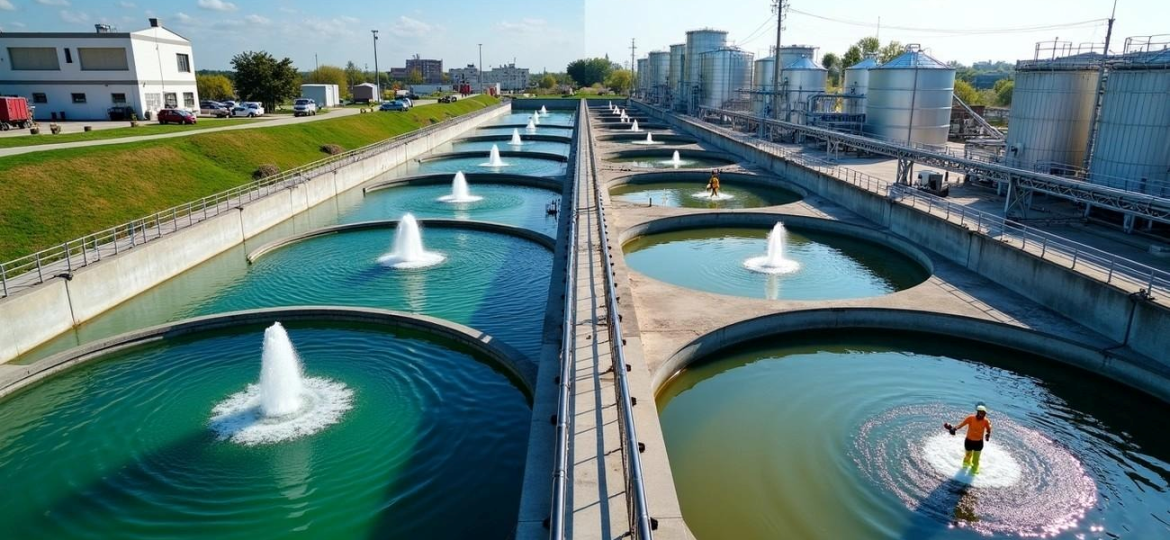
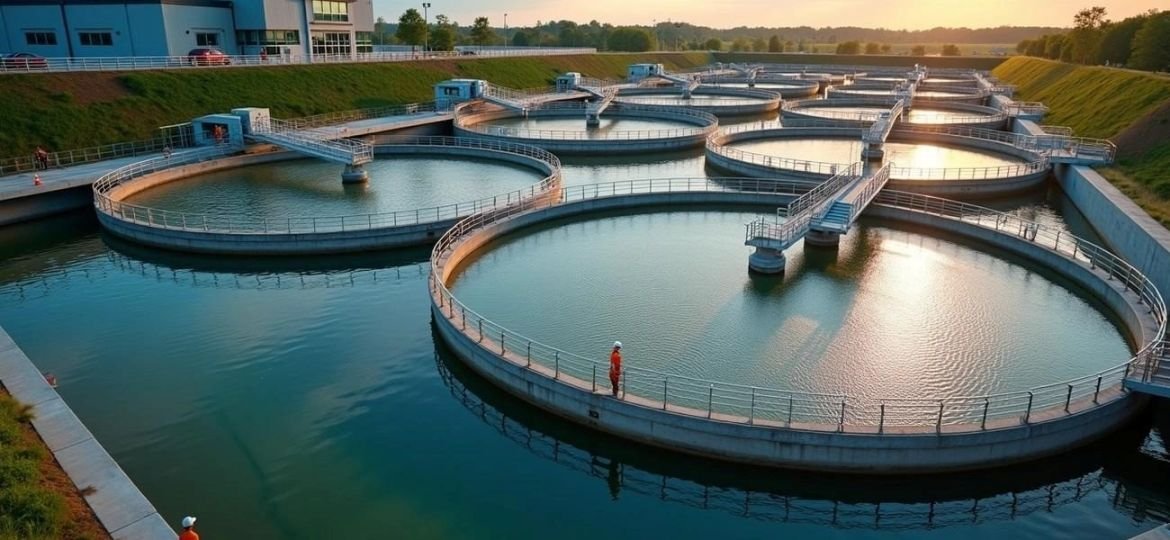
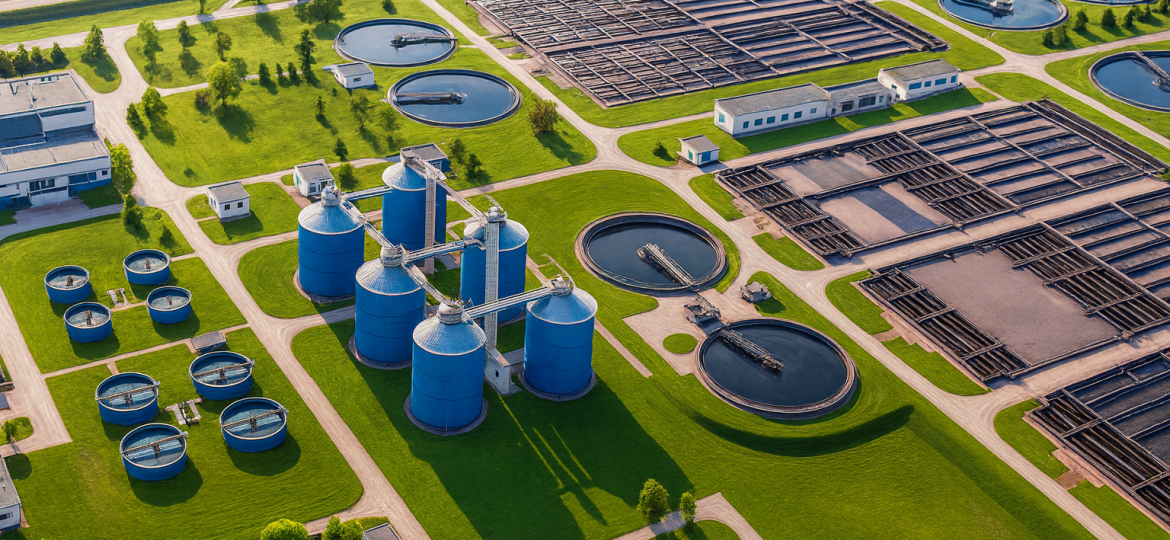
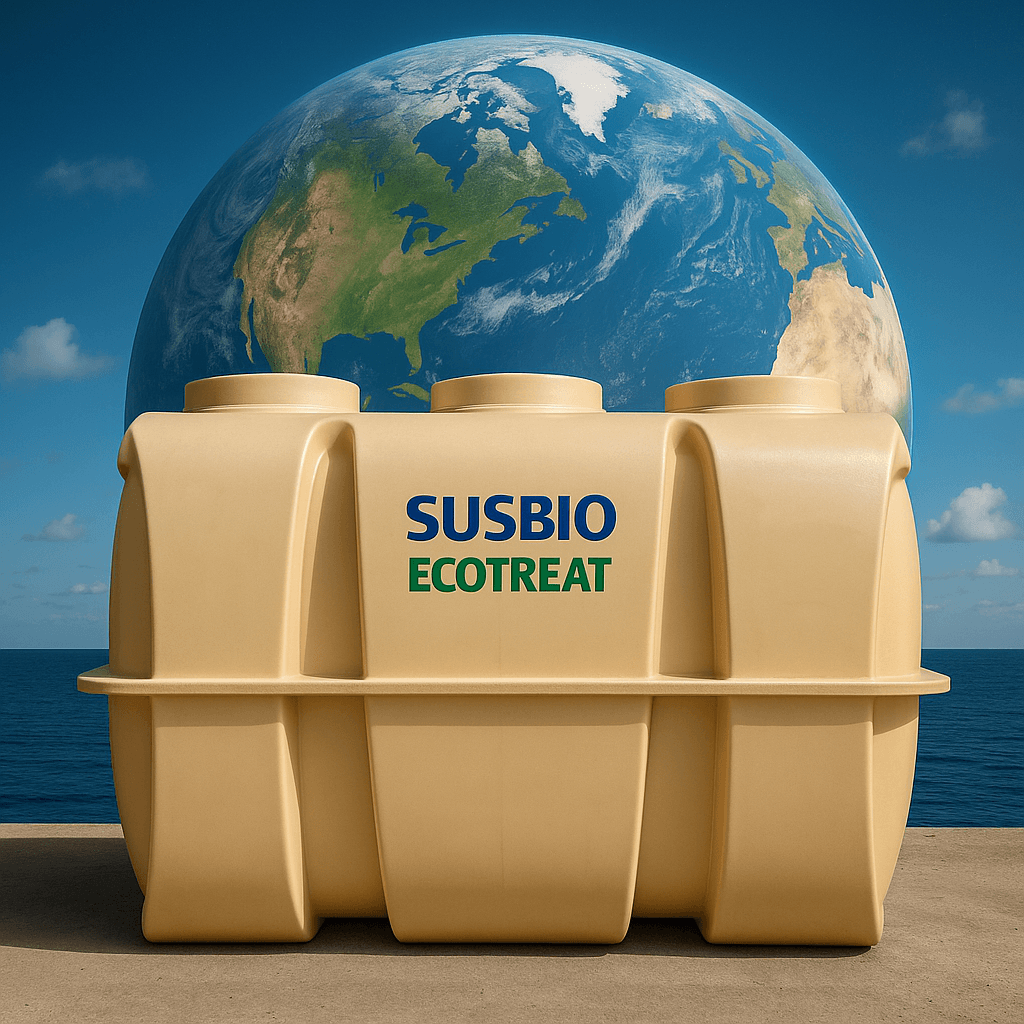
2 Comments
[…] Modern Sewage Treatment Plants (STPs) for residential plotting layouts are designed to treat sewage on-site, reducing dependence on municipal drainage systems. These compact, cost-effective, and eco-friendly STPs help residential communities meet environmental standards while promoting water conservation. […]
[…] of global concerns, understanding the sewage treatment process is more important than ever. Modern sewage treatment plants (STPs) not only protect public health and the environment but also enable the safe reuse of water […]